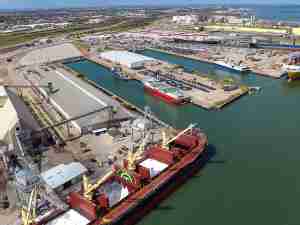The reductions are reflected in a comprehensive air emissions inventory of operations at the VPA’s marine terminals in 2011. The study was commissioned by the VPA as part of its ongoing, proactive environmental policy.
“Emissions, because they are mostly invisible, sometimes get lost in the conversation about larger environmental projects and efforts,” said Heather L. Wood, the VPA’s environmental affairs director. “The emissions inventory is among the drivers of our overall environmental program; it has an impact on several policies. It speaks to the efficiency of our operations and helps pinpoint areas that warrant further study.”
The VPA began modeling emissions from marine terminal operations in 2004 and has updated the emissions inventory in 2005, 2008 and 2011.
Since the first emissions inventory, the VPA has:
• Instituted a policy of cycling out older diesel engines in favor of Tier III diesels, the lowest emissions emitting engines available;
• Started using ultra-low sulfur diesel fuel in port vehicles well ahead of the federal mandate;
• Encouraged idle reduction among all types of cargo handling vehicles (vessels included), work vehicles and personal vehicles;
• Created the GO program – Green Operator – that provides low-interest loans to truck and fleet owners to update their vehicles with emissions-reducing technology or buy new trucks;
• Expanded GO to other modes with the creation of a voluntary, incentive-driven fuel switching program for cargo ships. This offshoot of GO encourages the use of locally-developed alternative fuel/hybrid technology to reduce emissions coming from vessels during cargo operations;
• Adopted and implement the ISO 14001 international environmental standards and practices;
• Started using ultra-low emission locomotives in the rail operation at Norfolk International Terminals (NIT) and expanded its on-dock rail services at NIT and APM Terminals;
• Reduced the overall number of truck trips between Hampton Roads and Richmond through use of the 64 Express barge service; and
• Shifted cargo from Portsmouth Marine Terminal to the more automated operations at APM Terminals.
“It is important to put this in context: Since 2004, pollutants from VPA and VIT owned, operated, and maintained cargo handling equipment have declined dramatically – in some cases almost totally eliminated, depending on the pollutant -- while total cargo volume increased by 28 percent over the same period (2004-2011),” said Rodney W. Oliver, the VPA’s interim executive director.
Port-related emissions generated from all cargo handling modes within the Hampton Roads Hampton Roads Ozone Attainment/Maintenance Area were modeled and evaluated. The evaluated modes included: ocean-going vessels; ship assist tugs known as harbor craft; cargo handling equipment; rail locomotives; and on-road heavy duty vehicles, which are primarily over-the-road trucks.
The methodology employed for preparing the emission inventories was consistent with U.S. Environmental Protection Agency best practices for mobile sources. Emissions levels were calculated using an integrated terminal capacity model developed by the engineering firm Moffatt & Nichol to assess activity and operational efficiency levels based on cargo throughput at the terminals.
The results of the 2011 inventory report emissions reductions for all criteria pollutants among all modes transporting containerized cargo through Hampton Roads are:
• Container volume increased 18.4 percent from 1,619,329 TEUs to 1,918,024 TEUs
• Emissions of oxides of nitrogen (NOx), an ozone contributing pollutant = -23%
• Particulate Matter (PM 2.5 & 10) = -50%
• Sulfur Dioxide (SO2) = -60%
• Ca










